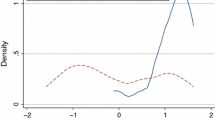Abstract
Previous studies have shown that the localisation of firms can be an important factor in attracting new foreign direct investment into a host country. The authors distinguish between “efficiency agglomerations” which arise as firms increase their efficiency by locating close to each other, and “demonstration effects” whereby existing firms send signals to new investors as to the reliability and attractiveness of the host country. They try to disentangle these two effects by examining the location of US firms in Ireland. They find that both sources of agglomerations have been important determinants of US firm entry into Ireland. JEL no. F23
Similar content being viewed by others
References
Barrell, R., and N. Pain (1999). Domestic Institutions, Agglomerations and Foreign Direct Investment in Europe.European Economic Review 43 (4/6): 925–934.
Barry, F., and J. Bradley (1997). FDI and Trade: The Irish Host-Country Experience.Economic Journal 107 (November): 1798–1811.
Barry, F., and A. Hannan (1996). On Comparative and Absolute Advantage: FDI and the Sectoral and Spatial Effects of Market Integration. Working Paper 96/19. Centre for Economic Research, University College Dublin.
Blonigen, B. A. (1997). Firm-Specific Assets and the Link between Exchange Rates and Foreign Direct Investment.American Economic Review 87 (3): 447–465.
Branstetter, L. (2000). Is Foreign Direct Investment a Channel of Knowledge Spillovers? Evidence from Japan’s FDI in the United States. NBER Working Paper 8015. National Bureau of Economic Research, Cambridge, Mass.
Braunerhjelm, P., and R. Svensson (1996). Host Country Characteristics and Agglomeration in Foreign Direct Investment.Applied Economics 28 (7): 833–840.
Braunerhjelm, P., and R. Svensson (1998). Agglomeration in the Geographical Location of Swedish MNFs. In P. Braunerhjelm and K. Ekholm (eds.),The Geography of Multinational Firms. Dordrecht: Kluwer Academic Publishers.
Buckley, P. J., and M. C. Casson (1998). Analyzing Foreign Market Entry Strategies: Extending the Internalization Approach.Journal of International Business Studies 29 (3): 539–562.
Coughlin, C. C., and E. Segev (2000). Location Determinants of New Foreign-Owned Manufacturing Plants.Journal of Regional Science 40 (2): 323–351.
Davis, S. J., and J. Haltiwanger (1992). Gross Job Creation, Gross Job Destruction and Employment Reallocation.Quarterly Journal of Economics 107 (3): 819–864.
DeCoster, G. P., and W. C. Strange (1993). Spurious Agglomeration.Journal of Urban Economics 33 (3): 273–304.
Driffield, N., and M. Munday (2000). Industrial Performance, Agglomeration, and Foreign Manufacturing Investment in the UK.Journal of International Business Studies 31 (1): 21–37.
Girma, S. (2002). The Process of European Integration and the Determinants of Entry by Non-EU Multinationals in UK Manufacturing.The Manchester School 70 (3): 315–335.
Görg, H., and E. Strobl (2002). Multinational Companies and Indigenous Development: An Empirical Analysis.European Economic Review 46 (7): 1305–1322.
Görg, H., and E. Strobl (2003). Multinational Companies, Technology Spillovers, and Plant Survival.Scandinavian Journal of Economics, forthcoming.
Head, K., J. Ries, and D. Swenson (1995). Agglomeration Benefits and Location Choice: Evidence from Japanese Manufacturing Investments in the United States.Journal of International Economics 38 (May): 223–247.
Jones, R. W. (1980). Comparative and Absolute Advantage.Schweizerische Zeitschrift für Volkswirtschaft und Statistik 3 (2): 235–260.
Kearns, A., and F. Ruane (2001). The Tangible Contribution of R&D Spending by Foreign-Owned Plants to a Host Region: A Plant Level Study of the Irish Manufacturing Sector (1980–1996).Research Policy 30 (2): 227–244.
Krugman, P. R. (1997). Good News from Ireland: A Geographical Perspective. In A. W. Gray (ed.),International Perspectives on the Irish Economy. Dublin: Indecon.
Krugman, P. R., and A. J. Venables (1995). Globalisation and the Inequality of Nations.Quarterly Journal of Economics 110 (4): 857–880.
Krugman, P. R., and A. J. Venables (1996). Integration, Specialization, and Adjustment.European Economic Review 40 (3): 959–967.
Marshall, A. (1920).Principles of Economics. London: Macmillan.
Milner, C., and E. Pentecost (1996). Locational Advantage and US Foreign Direct Investment in UK Manufacturing.Applied Economics 28 (5): 605–615.
O’Malley, E. (1995).An Analysis of Secondary Employment Associated with Manufacturing Industry. Dublin: Economic and Social Research Institute.
Ottaviano, G. I. P., and D. Puga (1998). Agglomeration in the Global Economy: A Survey of the “New Economic Geography”.World Economy 21 (6): 707–731.
Pavelin, S. (2000). The Geographical Diversification of Leading Firms in the EU. Working Paper 00/15. Centre for Economic Research, University College Dublin.
Ruane, F., and A. Ugur (2002). Foreign Direct Investment and Productivity Spillovers in Irish Manufacturing Industry: Evidence from Firm Level Panel Data. Trinity Economic Papers 02/06. Department of Economics, Trinity College Dublin.
Wheeler, D., and A. Mody (1992). International Investment Location Decisions: The Case of U.S. Firms.Journal of International Economics 33 (August): 57–76.
White, P. (2000). The Muscles of the Celtic Tiger: The IDA’s Winning Sectors. In R. MacSharry and P. A. White (eds.),The Making of the Celtic Tiger: The Inside Story of Ireland’s Boom Economy. Cork: Mercier Press.
Author information
Authors and Affiliations
Corresponding author
About this article
Cite this article
Barry, F., Görg, H. & Strobl, E. Foreign direct investment, agglomerations, and demonstration effects: An empirical investigation. Review of World Economics 139, 583–600 (2003). https://doi.org/10.1007/BF02653105
Issue Date:
DOI: https://doi.org/10.1007/BF02653105



